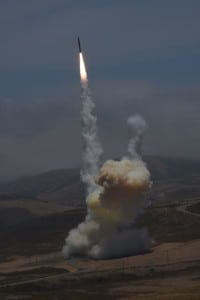According to a new Government Accountability Office (GAO) report, the Missile Defense Agency (MDA) was warned numerous times about problems with the now-canceled Redesigned Kill Vehicle (RKV) program as costs more than tripled before it was terminated.
“MDA and contractors did not adequately address technical risks despite numerous warnings from subject matter experts and officials within and outside of the RKV program about the performance issues, which later resulted in the program’s cancellation,” the 17th annual GAO report on MDA’s ballistic missile defense system capabilities said.
GAO said the most significant issue in the RKV cancellation was the program’s use of commercial off-the-shelf parts and re-use of Aegis Standard Missile (SM)-3 Block IIA components.

The cost to develop and finish initial production of the RKV also more than tripled the cost and lengthened the schedule by over four years before DoD canceled it.
“The program experienced significant cost and schedule increases over the span of 5 years, some of which occurred in the months leading up to the May 2019 stop-work order,” the report said.
The RKV was planned to upgrade the Ground-based Midcourse Defense (GMD) missile defense system’s Ground Based Interceptors (GBIs) with an improved kill vehicle while using the same booster rocker system. MDA planned to install 20 RKVs on GBIs at the Ft. Greeley, Alaska, missile site.
However, in 2019 MDA first announced a two-year delay to the RKV to push back the critical design review, then months later former Undersecretary of Defense for Research and Engineering Mike Griffin directed a stop-work order and start of an analysis of alternatives due to technical issues (Defense Daily, May 24, 2019).
Then, last August, DoD officially canceled RKV and redirected a new Next Generation Interceptor (NGI) program to replace it. The NGI includes a new booster rocket as well and not just a new kill vehicle (Defense Daily, Aug. 21).
Boeing [BA] was the prime contractor for RKV while Raytheon Technologies [RTX] was a subcontractor developing the actual RKV interceptor.
The GAO report recounts MDA reported the program’s financial issues were largely due to design rework, advance material purchases, schedule recovery efforts, and a large increase in staffing.
“These challenges alone increased RKV’s cost by $612 million and delayed the program by approximately 2 years,” GAO said.
Moreover, “at the time DoD canceled the RKV program in August 2019, MDA had spent a total of $1.21 billion on RKV development—$340 million more than the agency’s original estimate for the entire RKV development effort, including eight initial production kill vehicles,” the report said.
From 2015 to 2019, RKV’s total estimated cost increased by over 230 percent. While the initial production quantities increased from eight to 20 when MDA accelerated RKV in 2017, GAO said its analysis found this quantity change only made up less than 15 percent of the increased cost and schedule estimates.
GAO said while MDA chose off-the-shelf and SM-3 IIA components because of perceived maturity and cost savings, various actors identified specific performance risks over a decade.
During an SM-3 IIA technical interchange meeting in May 2010, experts from the Johns Hopkins University Applied Physics Laboratory provided the contractor with a briefing describing specific performance risks.
GAO found that “despite multiple efforts made by MDA’s engineering directorate to enforce requirements that would have necessitated design changes to address the performance risks, the program received formal agency approval in June 2015 to waive the requirements.”
The report said MDA and the contractor justified the waiver because performing a redesign after the critical design review (CDR) would significantly increase program costs and incur schedule delays.
Then five years later during an RKV system requirements review in November 2015 “the program identified and assessed performance risks as having a high likelihood of occurrence with major consequences.”
Yet, in the design review briefing the program noted it could make design changed later in the development process or seek waivers if mitigations were insufficient for the performance risks.
Another two years later in March 2017 during the RKV preliminary design review, the program asserted the RKV hardware reuse was “vigorously vetted, its design was appropriate for its requirements, and that the performance risks would be mitigated almost entirely.”
However, at the time a red team panel member warned the schedule did not give enough time to resolve any issues if the design mitigations were insufficient. GAO noted the objector was future and now former Undersecretary of Defense for Research and Engineering Mike Griffin.
Lastly, during an October 2018 briefing to decide if RKV was ready to conduct a CDR, the program presented a preliminary analysis of parts testing data, “which indicated significant performance risk.”
MDA and the contractor then decided to postpone the CDR to fiscal year 2021 while continuing to perform assessments and testing of suspect components. Then, in May 2019, Griffin directed MDA to stop work and start finding alternative courses.